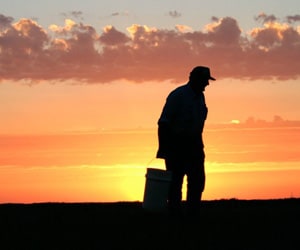FEBRUARY 2019
 The economic crisis in agriculture is not going away any time soon. More and more attention is being devoted to help farmers and others affected with resources aimed at dealing with the consequences – stress, anxiety, depression and suicide. UMASH partners with many of these organizations to offer help during these tough times.
The economic crisis in agriculture is not going away any time soon. More and more attention is being devoted to help farmers and others affected with resources aimed at dealing with the consequences – stress, anxiety, depression and suicide. UMASH partners with many of these organizations to offer help during these tough times.
In this article, Andrea Bjornestad, Assistant Professor in the Department of Counseling and Human Development at SDSU, shares information on South Dakota suicide statistics, symptoms to look for in people and resources devoted to help those in need.
This article was originally published January 2, 2019 in the South Dakota Farmers Union. Reprinted with permission.
Ag community told to look for signs of possible suicides
Lura Roti
South Dakota Farmers Union
Suicides among South Dakotans are on the rise, and farmers and ranchers are not immune.
“What is happening to producers is very serious,” says Andrea Bjornestad, South Dakota State University Assistant Professor & SDSU Extension Mental Health Specialist, during her presentation to family farmers and ranchers attending the 2018 South Dakota Farmers Union State Convention.
She referenced 2017 data showing that 192 South Dakotans committed suicide. And, although the state does not keep statistics on the careers of victims due to the rural nature of the state it is assumed that many of the 192 victims live in rural communities and may work in agriculture.
The reason the numbers are up? Bjornestad explained there are quite a few factors including chronic stress, limited access to mental health support and isolation.
Agriculture sustains one of the highest mortality rates from chronic stress. Suicide among farmers and ranchers is an international concern.
To prove this point, she showed the following data:
- One Australian farmer dies by suicide every four days;
- One farmer per week takes his or her own life in the United Kingdom;
- One farmer dies by suicide every two days in France;
- More than 270,000 farmers have died by suicide since 1995 in India.
With tough economic times and challenging weather, farmers and ranchers do not have control over many daily stressors. So, Bjornestad encouraged agriculture producers to make time for self-care. “Don’t isolate yourselves. Work to get more social interaction and peer support from other producers who understand,” she said.
“If you see someone struggling, socially withdrawing, behavioral changes, don’t hesitate to ask them if they are thinking about killing themselves,” Bjornestad says. “Don’t be afraid to ask the tough questions. Your asking will not impact a person’s response or thoughts.”
In addition to the risk of isolation, Bjornestad explained that the rural nature of South Dakota means less access to mental health support.
Bjornestad’s message hit home for many S.D. Farmers Union members.
- “Between mental health and the opioid crisis, I think it’s a coming storm,” says Dallis Basel, Union Center rancher and District 5 board member. “As we saw during the farm crisis of the ’80s suicides went up.”
- The current situation also reminded Audrey Keierleber of the 1980s. “Like the ’80s, we’re in a situation where expenses are going up, up, up and income is going down, down, down, and there are younger farmers and ranchers who got into production agriculture during the good times. They have never seen the bad times until now.” Keierleber added that she recently heard that the Nebraska Suicide Prevention hotline has recently had more calls than in the 1980s.
- In addition to tough economic times in agriculture, there are many veterans returning to rural communities and dealing with post-traumatic stress disorder (PTSD) explained Ray Martinmaas, an Orient crop and cattle producer. “Everyone is under so much pressure due to the economy and outside factors that we need to watch out for everyone in our communities.”
- Lorrie Hanson agreed. “The markets impact everyone in rural communities. We all feel the lows and the highs.”
If you or someone you know needs support
Call an expert at the free, Iowa Concerns Hotline 24/7:
1-800-447-1985
A confidential service provided by Iowa State University that also provides support to South Dakotans.
Helpline Center:
Call 1-800-273-8255 or text sdfarm to 898211
Avera Hotline:
1-800-691-4336
 Andrea Bjornestad, Assistant Professor in the Department of Counseling and Human Development at South Dakota State University and SDSU Extension Mental Health Specialist, can also be contacted at:
Andrea Bjornestad, Assistant Professor in the Department of Counseling and Human Development at South Dakota State University and SDSU Extension Mental Health Specialist, can also be contacted at:
Phone: 605-688-5125
Email: Andrea.Bjornestad@sdstate.edu

 Stress, depression, and suicide are on the mind of agricultural communities, where economic, social, and environmental forces challenge the health and safety of farmers, agricultural workers and their families.
Stress, depression, and suicide are on the mind of agricultural communities, where economic, social, and environmental forces challenge the health and safety of farmers, agricultural workers and their families.